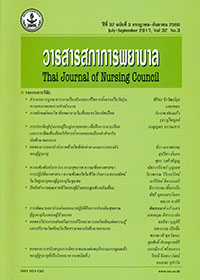ผลของการสนับสนุนการจัดการตนเองต่อพฤติกรรมการดูแลเท้าของผู้สูงอายุที่เป็นโรคเบาหวานชนิดที่ 2
Keywords:
การสนับสนุนการจัดการตนเองในการดูแลเท้า, พฤติกรรมการดูแลเท้า, ผู้สูงอายุที่เป็นโรคเบาหวานชนิดที่ 2, self-management supporting program for foot care, foot care behaviors, Older Persons with Type 2 Diabetes MellitusAbstract
Objective: To study the effect of a self-management supporting program on foot care behavior among older persons with type 2 diabetes.
Design: Quasi experimental research.
Procedure: Purposive sampling was used to recruit participants from Thasala hospital and Noppitum hospital, Nakhon Si Thammarat province. Participants were assigned into the experimental and control groups; 22 persons in the experimental group and 26 persons in the control group. The experimental group attended the self-management supporting program for 6 weeks, while the control group did not participate in this self-management supporting program. The instruments used in this study consisted of self-management supporting program for foot care in the elderly, the self-management education manual, a videotape about foot care, videotape about foot exercise, and videotape about foot massage for older persons with type 2 diabetes, and the perceived self-efficacy questionnaire. Data collection tools consisted of the Demographic Data Recording Form and a Foot Care Behaviors Questionnaire. Data were analyzed using descriptive statistics, independent t-test, and paired t-test.
Results: Older people with type 2 diabetes who attended the self-management supporting program had significantly higher foot care behaviors than that of the group who did not participate in the self-management supporting program at level of p < 0.001, and after attending the self-management supporting program, older people with type 2 diabetes had significantly higher foot care behaviors than before attending the program at level of p < 0.001.
Recommendations: The results of this study indicate that the self-management support program can increase foot care behaviors among older people with type 2 diabetes who had category 1 at risk for developing foot ulcers.
Keywords: self-management supporting program for foot care; foot care behaviors; Older Persons with Type 2 Diabetes Mellitus
Downloads
References
elderly. Diabet Med 2007; 1(33): 56-66.
2. Moakes H. An overview of foot ulceration in older
people with diabetes: diabetic complications can
result in foot ulcers that may become infected, so it
is vital that nurses know when to refer patients.
Nurs Older People 2012; 24(7): 9-14.
3. Institute of Medical Research and Technology
Assessment. Diabetes education for self-management.
2nd ed. Bangkok: The Agricultural Co-operative
Federation of Thailand; 2010. (In Thai)
4. Frykberg RG, Zgonis T, Armstrong DG, Driver VR,
Giurini JM, Kravitz SR, et al. Diabetic foot disorders:
a clinical practice guideline (2006 revision). J Foot
Ankle Surg 2006; 45(5): 1-66.
5. Boulton AJ, Vileikyte L, Ragnarson-Tennvall G,
Apelqvist J. The global burden of diabetic foot disease.Lancet 2005; 366(12): 1719-24.
6. Price P. The diabetic foot: quality of life. Clin Infect
Dis 2004; 39 (Suppl 2): 129-1
7. Adeyi A, Muzerengi S, Adeyi IG, Gupta I. Leg ulcers
in older people: a review of management leg ulcers
in older people: a review of management. Br. J.
Med. Pract 2009; 2(3); 21-28.
8. Dall T, Nikolov P, Hogan P. Economic costs of
diabetes in the US in 2002. Diabetes care 2003;
26(3): 917-2.
9. Vuorisalo S, Venermo M, Lepäntalo M. Treatment
of diabetic foot ulcers. J Cardiovasc Surg 2009;
50(3): 275-1.
10. Peters EJ, Lavery LA. Effectiveness of the diabetic
foot risk classifcation system of the international
working qroup on the diabetic foot. Diabetes care
2001; 24(8): 1442-47.
11. Calle-Pascual AL, Durán A, Benedı́ A, Calvo MI,
Charro A, Diaz JA, et al. A preventative foot care
programme for people with diabetes with different
stages of neuropathy. Diabetes Res Clin Pract 2002;
57(2): 111-7.
12. Ruangoj P, Masingboon K, Keeratiyutawong P.
Predictors of foot status among persons with diabetes
mellitus at police general hospital. Journal of Faculty
of Nursing Burapha University. 2010; 18(1): 68-83.
(In Thai)
13. Lorig K. Self-management of chronic illness: a model
for the future. Generations 1993; 17(3): 11-14.
14. Lorig KR, Holman HR. Self-management education:
history, defnition, outcomes, and mechanisms. Ann
behav med 2003; 26(1): 1-7.
15. Sae-Sia W, Maneewat K, Kurniawan T. Effect of a
self-managemennt support program on diabetic foot
care behaviors. Int J Res Nurs 2013; 4(1): 14-21.
16. Chayasiriphan K, Wachirawat W, Keeratiyutawong P.
Impact of self-management practice programe on
knowledge, self-management behaviour and HbA1c
level in insulin-dependent type-2 diabetes patiens.
Thai Journal of Nursing Council 2016; 31(1):
70-82. (In Thai)
17. Cohen J. Statistical power analysis for the behavioral
sciences. 2nd ed. Hilsdale (NJ): Lawrence Earlbaum
Associates; 1988.
18. Polit DF, Beck CT. Nursing research: generating
and assessing evidence for nursing practice. Lippincott
Williams & Wilkins; 2008.134
19. Himathongkham T, World Diabetes Foundation,
Foundation for the Development of Diabetes Care,
Theptarin Hospital. Foot care for people with diabetes.
[serial online]. 2012 [cited 2016 May 1]. Avilable
from:https://www.youtube.com/watch?v=whs
77l5JJws. (In Thai)
20. Prakamsri N, Raksasonthi CH, Choodoung J, Pranagklao
Hospital, Mahidol University. Foot exercise for people
with Diabetes. [serial online]. 2014 [cited 2016 May
1]. Avilable from: https://www.youtube.com/watch?
v=Sq3WMXOD Wxo&t=14s. (In Thai)
21. Abhaiphubeihr Hospital. Foot massage for elderly
with type 2 diabetes. [serial online]. 2013 [cited 2016
May1]. Avilable from: https://www.youtube.com/
watch?v=6Kww6Flqkvo#t=162&hd=1/. (In Thai)
22. Sutthilak CH. Effects of self-management supporting
program on self-management behaviors and serum
lipid level among elders with dyslipidemia. Nursing
Journal. 2012; 39(4), 110-3. (In Thai)
23. Fan L, Sidani S. Effectiveness of diabetes selfmanagement education intervention elements: a
meta-analysis. Can J Diabetes 2009; 33(1): 18-26.








